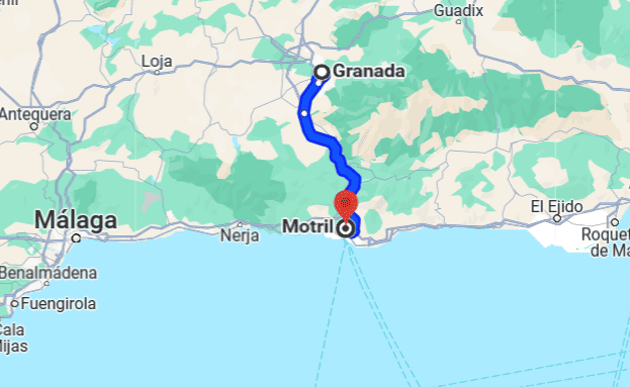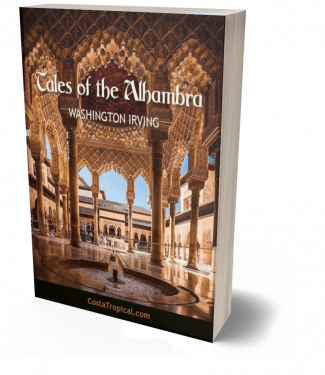- Home
- Listings
- Things To See & Do
- Car Hire
- News
- Properties
- What’s On
ES
The Alhambra
The Alhambra sits atop a hill overlooking the city of Granada, just an hour’s drive from the Costa Tropical. Often referred to as the Eighth Wonder of the World, the Alhambra is a palace and fortress complex of the Moorish monarchs of Granada, in southern Spain (known as Al-Andalus when the fortress was constructed), occupying a hill on the south-eastern border of the city of Granada. It was the residence of the Muslim kings of Granada and their court. A Renaissance palace was also added by Charles V, Holy Roman Emperor. The Alhambra and the surrounding area – including the gardens of the Generalife – is a UNESCO World Heritage Site and museum exhibiting exquisite Islamic architecture.
History
The name Alhambra derives from the the Arabic words “al hamra”, meaning “the red”, a reference to the colour of the red clay of which the building is made. (The English word “amber” is derived from a related word in old Arabic: “anbar”).
The first reference to the Qal’at al Hamra was during the battles between the Arabs and the Muladies during the rule of the Abdallah (who reigned from 888-912). In one particularly fierce and bloody skirmish, the Muladies soundly defeated the Arabs who were then forced to take shelter in the Alhambra. According to surviving documents from the era, the red castle was quite small at that time, and evidence from Arab texts suggests that the building was extended to its present size some time later, almost certainly during the Nasrid Dynasty.
There are no further historical references to the Alhambra until the eleventh century when its ruins were renovated and rebuilt by Samuel ibn Naghralla, vizier to the King Badis of the Zirid Dynasty, in an effort to preserve the small Jewish settlement also located on the Sabikah hill.
Palaces
Ibn Nasr, the founder of the Nasrid Dynasty, was forced to flee to Granada in order to avoid persecution by King Ferdinand and his supporters during attempts to rid Spain of Moorish Dominion. After retreating to Granada, Ibn-Nasr took up residence at the Palace of Badis in the Alhambra. A few months later, he embarked on the construction of a new Alhambra fit for the residence of a king. According to an Arab manuscript published as the Anónimo de Granada y Copenhague, “This year 1238 Abdallah ibn al-Ahmar climbed to the place called the Alhambra, inspected it, laid out the foundations of a castle, and left someone in charge of its construction.” The design included plans for six palaces, five of which were grouped in the northeast quadrant forming a royal quarter, two circuit towers, and numerous bathhouses. Over the reign of Nasrid Dynasty, the Alhambra was transformed into a palatine city complete with an irrigation system composed of acequias for the lush and beautiful gardens of the Generalife located adjacent to the fortress. Previously, the old Alhambra structure had been dependent upon rainwater collected from a cistern and from what could be brought up from the Albaicín. The creation of the “Sultan’s Canal” solidified the identity of the Alhambra as a sumptuous palace-city rather than a defensive and ascetic structure.
Independent visit
Tickets are often sold out days or even weeks in advance, so it is advisable to book early to avoid disappointment. Tickets can be purchased on the Alhambra ticket office website, or by telephone at (34) 858 889 002.
Same day tickets can be bought from machines located in the Alhambra and in the Andalusi monuments (Corral del Carbón, Bañuelo y Palacio Dal al Horra), subject to availability.
We strongly recommend booking an official guided tour which includes an entrance ticket. Click here to view our list of guided tour options.
Complete Guide to Visiting the Alhambra: Tickets, Audioguides, and Guided Tours
The Alhambra is one of Spain’s most iconic destinations, and planning your visit properly will ensure an unforgettable experience. The general ticket costs €19.09 and includes access to the Nasrid Palaces, the Alcazaba, and the Generalife, with an approximate duration of three hours. If you only want to visit the Generalife and the Alcazaba, the ticket is €10.61. There’s also the Dobla de Oro option (€27.30), which includes the Alhambra and four Andalusian monuments in the Albaicín neighborhood. Remember that tickets are personal and non-transferable, so you must bring your passport or ID along with your ticket throughout the visit.
For a magical evening, consider the night visit to the Nasrid Palaces (€10.61), which includes the Mexuar, the Comares Palace, the Palace of the Lions, and the Lindaraja Corridor. The palaces are illuminated with special lighting, offering an extraordinary experience. Winter hours are from 8:00 PM to 9:30 PM, and summer hours are from 8:00 PM to 11:30 PM.
To enrich your visit, you can rent an interactive audioguide . Once you arrive at the Alhambra, you can rent the interactive audioguide service. This is is available on the premises, or for download on iOS and Android devices. This tour guide includes an interactive map of the complex, audios, historical images, videos and 360º panoramic views. The visitor can choose between several routes adapted to different itineraries, tastes and available time. The price is 6 euros and it is available in German, Arabic, Korean, Chinese, Spanish, French, Dutch, English, Italian, Japanese, Portuguese and Russian.
If you prefer a more personalized experience, official guided tours are an excellent choice, led by accredited expert guides. Immerse yourself in the rich history and majesty of this unique place! Click here to view our selected list of guided tours.
Directions: If you are driving from the Costa Tropical to Granada, take the A44 motorway, which becomes the GR30. Take exit 16, Ronda Sur/Sierra Nevada/Alhambra/Campus de la Salud. Follow signs to the Alhambra.
By Bus: There are buses to Granada every hour from Almuñécar, Salobreña, Motril and most of the other towns in the Costa Tropical.
From Granada city centre, take the number 30 or 32 bus to the Alhambra.

Alhambra Guided Tours
A visit to Granada wouldn't be complete without seeing the Alhambra. Click the button to check out our suggested guided tours.
Tales of the Alhambra FREE ebook download
Our gift to you. “Tales of the Alhambra” is a collection of stories by the American author Washington Irving, inspired by, and partly written during his visit to the Alhambra in 1828. Irving was a guest at the ancient fortress, where he found himself in the company of several colourful residents. During his stay, Irving became increasingly enamoured with the grand palace and its wealth of history and folklore. The result is this captivating collection of essays, sketches, and anecdotes. “Tales of the Alhambra” is must-read for modern-day visitors to the Alhambra. Click the link below to download in either Epub or PDF format.

FAQ
Tickets can be purchased through several options:
- Online: Via the official ticketing website.
- By phone: Call +34 858 889 002.
- Ticket vending machines: Located at the ticket pavilion, Corral del Carbón, Bañuelo, and Dar al-Horra Palace.
- At the ticket office: Only same-day tickets are sold here, subject to availability, and can only be purchased up to two hours before the Nasrid Palaces entry time.
Entry for children under 12 years old is free, but a ticket must be obtained.
For children aged 3 to 11 years, tickets must be reserved at the time of purchase and managed along with the adult tickets.
Tickets for children under 3 years old can be obtained at the monument’s ticket office or at the entrance. No prior reservation is needed
Consider purchasing the Granada Card, which include access to the Alhambra even when general tickets are unavailable.
No, once your purchase is confirmed, you cannot change the date, time, or cancel the visit and obtaining refund.
Visitors can enter through the main ticketed entrance near the Alhambra parking area or the Justice Gate.
You must arrive at the Nasrid Palaces at the exact time indicated on your ticket. Late arrivals are not permitted.
It is recommended to bring a printed ticket in A4 format or the type of ticket provided at the monument’s ticket office or vending machines. This helps speed up access to the various areas you will visit. However, you can also show your ticket on your mobile device if preferred.
A full visit takes approximately three hours, including the Nasrid Palaces, Generalife, and Alcazaba.
The tour of the Nasrid Palaces takes about one hour.
Early morning or late afternoon are ideal for avoiding crowds and enjoying cooler temperatures in the summer.
The Alhambra’s general daytime visit hours vary depending on the season:
- Summer (From April 1 to October 14): Open daily from 08:30 AM to 8:00 PM. The ticket office operates from 08:00 AM to 8:00 PM.
- Winter (From October 15 to March 31): Open daily from 08:30 AM to 6:00 PM. The ticket office operates from 08:00 AM to 6:00 PM.
Night visits showcase the Nasrid Palaces under special illumination, providing a magical and intimate experience.
You can visit most areas in any order, but the Nasrid Palaces require entry at the specific time on your ticket.
The Alhambra can be reached on foot, by taxi, or using city buses like the C30 or C32.
Yes, there is paid parking available close to the main entrance.
Yes, but flash photography and tripods are not allowed inside certain areas.
Baby strollers are not allowed inside the visitable areas (Nasrid Palaces, Generalife, Alcazaba, Partal, or the Alhambra Museum). However, there is a free stroller storage and baby carrier rental service available upon presenting your ticket for the day. Visitors can leave their stroller at the Puerta del Vino storage and receive a baby carrier (for children up to 12 kg) in exchange.
Large bags (more than 40×40 cm) must be stored in lockers at the entrance.
Yes, benches and shaded areas are scattered throughout the grounds.
While there are no full-service restaurants within the Alhambra complex, visitors can find:
- Vending machines: Located inside near Puerta del Vino and the Carlos V Palace.
- Two kiosks: One near the Alcazaba and another at the entrance pavilion.
Just outside the Alhambra, several restaurants offer dining options:
- La Mimbre: Situated between the Alhambra and the Generalife.
- Jardines Alberto: Located at Paseo de la Sabika 1.
- Casa Torcuato Alhambra: Found at Paseo de la Sabika 24.
.
